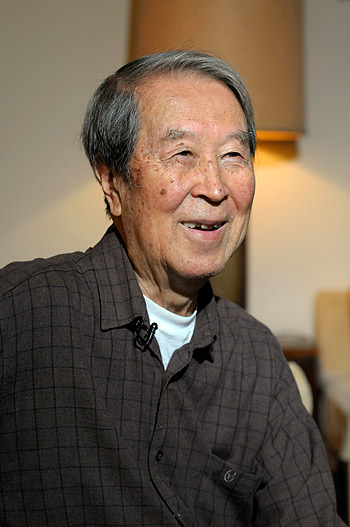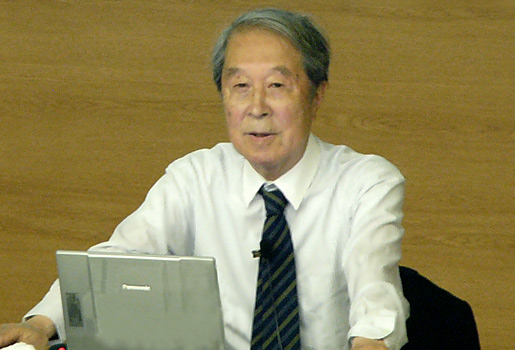2007 - А.А. Белавин и Y. Nambu
Pomeranchuk Prize Winners 2007
According to the decision of the International Pomeranchuk Prize Committee the Pomeranchuk Prize for 2007 is awarded to Alexander Belavin (Landau Institute for Theoretical Physics, Moscow) and Yoichiro Nambu (Enrico Fermi Institute, University of Chicago

Laureate of the Pomeranchuk Prize 2007
Alexander Belavin receiving the diploma from
the Chairmanof the Committee Alexey Kaidalov
(February 2009)
The Prize is awarded to Alexander Belavin for remarkable achievements in quantum field theory, such as instanton solutions in QCD, and deep insights in two-dimensional conformal string theory. A.A. Belavin is a Professor at L.D. Landau Institute for Theoretical Physics. Among his most considerable achievements there is a discovery of BPST (Belavin-Polyakov-Shvarts-Tyupkin) instantons in non-Abelian gauge theory in 1975. This provided a qualitative explanation of the quark confinement phenomena and U(1)-problem and initiated a new direction in Quantum Field Theory.
In 1973 A. Belavin in collaboration with G.Avdeeva discovered a non-trivial zero of Gell-Mann - Low and a scaling regime in a guage field theory, proving a possibility of a new strong coupling regime of non-perturbative nature. Belavin found a broad class of new exact S-matrices, (Belavin's S matrices), and proposed corresponding exactly solvable models in two-dimensional relativistic theories in 1981
In the celebrated BPZ (Belavin-Polyakov-Zamolodchikov) paper of 1984 a formulation of two-dimensional conformal field theories was given. The conformal field theory plays a fundamental role in a modern string theory at critical and non-critical space-time dimensions. The discovery by A.A. Belavin and V.G. Knizhnik of a holomorphic property (Belavin-Knizhnik's theorem) for the dual amplitudes in string theory in 1986 allowed working out explicit expressions for amplitudes of critical strings up to the fourth order.
Most recent development of conformal field theory and Liouville gravity theory includes exact expressions for multiparticle Veneziano amplitudes in Polyakov's string (in collaboration with A. Zamolodchikov).
The Prize is awarded to Yoichiro Nambu for outstanding contributions to elementary particle physics, including spontaneous symmetry breaking, colored gluons and string theory, that have had such a major impact on our understanding of these key concepts for a number of decades. Yoichiro Nambu is Harry Pratt Judson Distinguished Service Professor Emeritus, Dept. of Physics and Enrico Fermi Institute. He received his Doctor of Science degree from the University of Tokyo in 1952. In 1952, he was invited to the Institute for Advanced Study in Princeton. He became Professor of Physics at the University of Chicago in 1958, where, from 1974 to 1977, he was also Chairman of the Department of Physics.
Nambu has made many important contributions to the development of elementary particle theory. He is famous for having proposed the "color charge" of quantum chromodynamics, for having done early work on spontaneous symmetry breaking in particle physics, and for having discovered that the dual resonance model could be explained as a quantum mechanical theory of strings. He is accounted as one of the founders of string theory.
The spontaneous symmetry breaking model of hadron mass generation was developed by Nambu, together with Jona-Lasinio. This model is based on an analogy with the BCS theory of superconductivity. The modern version of the N(ambu)--J(ona)-L(asinio) Model is a low energy approximation to Quantum Chromodynamics. It also gives important insight into the nucleon-nucleon force, both in free space and in nuclei. Some features of nuclei, such as the approximate validity of the interacting boson model, appear to be due to a manifestation of spontaneous symmetry breaking due to the nuclear pairing interaction. The NJL model was originally proposed around 1960, before it was realized that nucleons are made up of three quarks. However, Nambu. with Han, did some pioneering work along these lines concerning gluons.
Nambu and Han generalized this idea to strong interactions, and proposed that the force between quarks is carried by gluons. In the original version of Nambu's work, the quarks were taken to have integral charges, but that was later corrected by Gell-Mann who introduced fractional charges.
The Nambu-Goto action in string theory is named after Nambu and Tetsuo Goto. Also, massless bosons arising in field theories with spontaneous symmetry breaking are sometimes referred to as Nambu-Goldstone bosons
Y. Nambu has won numerous honors and awards including the J. Robert Oppenheimer Prize, the U.S.'s National Medal of Science, Japan's Order of Culture, the Planck Medal, the Wolf Prize, the Franklin Medal, the Dirac Medal and the Sakurai Prize.

Yoichiro Nambu - Nobel Prize
winner 2008








